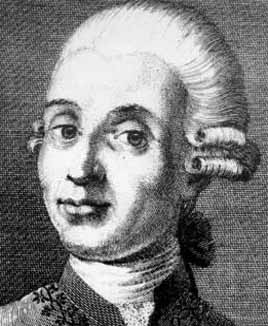

تاريخ الرياضيات

الاعداد و نظريتها

تاريخ التحليل

تار يخ الجبر

الهندسة و التبلوجي


الرياضيات في الحضارات المختلفة

العربية

اليونانية

البابلية

الصينية

المايا

المصرية

الهندية


الرياضيات المتقطعة

المنطق

اسس الرياضيات

فلسفة الرياضيات

مواضيع عامة في المنطق


الجبر

الجبر الخطي

الجبر المجرد

الجبر البولياني

مواضيع عامة في الجبر

الضبابية

نظرية المجموعات

نظرية الزمر

نظرية الحلقات والحقول

نظرية الاعداد

نظرية الفئات

حساب المتجهات

المتتاليات-المتسلسلات

المصفوفات و نظريتها

المثلثات


الهندسة

الهندسة المستوية

الهندسة غير المستوية

مواضيع عامة في الهندسة

التفاضل و التكامل


المعادلات التفاضلية و التكاملية

معادلات تفاضلية

معادلات تكاملية

مواضيع عامة في المعادلات


التحليل

التحليل العددي

التحليل العقدي

التحليل الدالي

مواضيع عامة في التحليل

التحليل الحقيقي

التبلوجيا

نظرية الالعاب

الاحتمالات و الاحصاء

نظرية التحكم

بحوث العمليات

نظرية الكم

الشفرات

الرياضيات التطبيقية

نظريات ومبرهنات


علماء الرياضيات

500AD

500-1499

1000to1499

1500to1599

1600to1649

1650to1699

1700to1749

1750to1779

1780to1799

1800to1819

1820to1829

1830to1839

1840to1849

1850to1859

1860to1864

1865to1869

1870to1874

1875to1879

1880to1884

1885to1889

1890to1894

1895to1899

1900to1904

1905to1909

1910to1914

1915to1919

1920to1924

1925to1929

1930to1939

1940to the present

علماء الرياضيات

الرياضيات في العلوم الاخرى

بحوث و اطاريح جامعية

هل تعلم

طرائق التدريس

الرياضيات العامة

نظرية البيان
Gian Francesco Malfatti
المؤلف:
A Natucci
المصدر:
Biography in Dictionary of Scientific Biography
الجزء والصفحة:
...
23-3-2016
1589
Born: 1731 in Ala, Trento, Italy
Died: 9 October 1807 in Ferrara, Italy

Gianfrancesco Malfatti studied under Vincenzo Riccati, F M Zanotti, and G Manfredi at the College of San Francesco Saverio in Bologna. Then, in 1754, Malfatti went to Ferrara where he taught mathematics and physics in a school that he started up there.
The University of Ferrara was erected by Alberto V who reigned over Ferrara from 1388 to 93. The University was obtained by Pope Boniface IX as a concession in 1391 and this is taken as its founding date. Copernicus studied there in 1503 but the buildings which house the University today date from the end of the 16th-century. The University of Ferrara was re-established in its 16th-century buildings in 1771 and Malfatti was appointed to the chair of mathematics there in that year.
Struik, describing the papers in [2], writes that Malfatti:-
... was a quiet, scholarly man who spent most of his life as a librarian and professor in Ferrara. He was one of the founders of the "Societa Italiana delle Scienze" (1782) and was active in academic reform, especially in the Napoleonic period.
Malfatti wrote an important work on equations of the fifth degree. In 1802 he gave the first solution to the problem of describing in a triangle three circles that are mutually tangent, each of which touches two sides of the triangle, the so-called Malfatti problem. His solution was published in a paper of 1803 on un problema stereotomica.
Jacob Bernoulli had solved this for an isosceles triangle while, after Malfatti, the problem was also solved by Steiner and Clebsch, the latter solving it using elliptic functions.
Malfatti's interests extended beyond this geometrical problem, however:-
His papers dealt with many subjects from probability to mechanics and he participated in the debate around Ruffini's attempt to prove the impossibility of solving (in the meaning of that period) equations of higher degree than four.
There are several papers in [2] which describe Malfatti's work. These include: Problems and methods of mathematical analysis in the work of Gianfrancesco Malfatti, Contributions of Gianfrancesco Malfatti to combinatorial analysis and to the theory of finite difference equations, The work of Malfatti in the realm of mechanics, The geometrical research of Gianfrancesco Malfatti, Gianfrancesco Malfatti and the theory of algebraic equations, and Gianfrancesco Malfatti and the support problem.
We should note some interesting results which he obtained. In 1781 he showed that the lemniscate had the property that [1]:-
... a mass point moving on it under gravity goes along any arc of the curve in the same time as it traverses the subtending arc.
- A Natucci, Biography in Dictionary of Scientific Biography (New York 1970-1990).
http://www.encyclopedia.com/doc/1G2-2830902786.html
Books:
- Gianfrancesco Malfatti nella cultura del suo tempo, Proceedings of the Conference on Gianfrancesco Malfatti (Ferrara, 1982).
Articles:
- E Bortolotti, Sulla risolvente di Malfatti, Atti dell'Accademia di Modena 7 (1906).
- A Fiocca, Malfatti's problem in nineteenth-century mathematical literature (Italian), Ann. Univ. Ferrara Sez. VII (N.S.) 26 (1980), 173-202.
- L Miani, I Ventura and S Giuntini, The Gianfrancesco Malfatti - Sebastiano Canterzani correspondence (Italian), Boll. Storia Sci. Mat. 3 (2) (1983).
 الاكثر قراءة في 1700to1749
الاكثر قراءة في 1700to1749
 اخر الاخبار
اخر الاخبار
اخبار العتبة العباسية المقدسة

الآخبار الصحية















 قسم الشؤون الفكرية يصدر كتاباً يوثق تاريخ السدانة في العتبة العباسية المقدسة
قسم الشؤون الفكرية يصدر كتاباً يوثق تاريخ السدانة في العتبة العباسية المقدسة "المهمة".. إصدار قصصي يوثّق القصص الفائزة في مسابقة فتوى الدفاع المقدسة للقصة القصيرة
"المهمة".. إصدار قصصي يوثّق القصص الفائزة في مسابقة فتوى الدفاع المقدسة للقصة القصيرة (نوافذ).. إصدار أدبي يوثق القصص الفائزة في مسابقة الإمام العسكري (عليه السلام)
(نوافذ).. إصدار أدبي يوثق القصص الفائزة في مسابقة الإمام العسكري (عليه السلام)


















